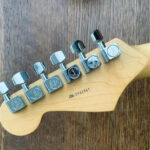As a long-time enthusiast venturing through the landscape of guitar MIDI technology, I’ve witnessed its evolution firsthand. From early experiments to today’s sophisticated devices, the quest for seamless guitar-to-MIDI conversion has been a fascinating journey. My exploration started years ago with Jam Origins on IOS, an intriguing concept that, in my experience, fell short when compared to the responsiveness of dedicated hardware like the AXON. Recently revisiting their website and seeing the development of a Windows version has sparked renewed interest, and I’m eager to test if it lives up to the promise shown in their promotional videos. I’m diving in to give it a try and will share my findings.
My personal history with pitch-to-MIDI conversion spans three decades – a period filled with both triumphs and frustrations in the pursuit of glitch-free tracking. Among the various converters I’ve owned, the AXON AX 100 MKII stands out as the pinnacle of 13-pin technology. Although it’s an older, discontinued model, it represents a peak in what 13-pin converters could achieve. The software interface of the AXON offered unparalleled flexibility, allowing for complete customization of the fingerboard mapping. A particularly innovative feature was its ability to track “pick direction,” enabling patch assignment based on playing nuances – a level of control rarely seen in other systems.
An interesting, albeit impractical, technique from the past to enhance tracking involves using “B” strings (.013 gauge, tuned to B) for all six strings of the guitar. This modification significantly improves tracking accuracy but fundamentally alters the guitar’s playability and renders it essentially unusable for standard guitar playing. Despite its drawbacks, this trick is worth mentioning, especially if you’re deeply exploring the technical aspects of guitar MIDI conversion and haven’t encountered it before. It undeniably demonstrates a method to push tracking performance to its limits.
When it comes to pure speed in 13-pin-to-MIDI conversion, the AXON devices are hard to surpass. However, devices that trigger sounds internally, bypassing MIDI output altogether, often provide a faster and more responsive playing experience. In this category, the Roland GR-55 and the now discontinued VG-99 stand out as exceptional offerings in the current and recent market. These units minimize latency by processing and generating sounds within the device itself, leading to a more immediate and natural feel for the guitarist.
Over the years, my collection of guitar MIDI gear has included a range of notable devices. I’ve owned the Roland GR-20, GI-20, GR-707, and GR-300 (and still occasionally use the GR-20, despite its quirks). Other units I’ve explored include the IVL Pitchrider (also marketed by Kramer), the Photon (which utilized non-visible light string sensors), and the unique Casio MG-510 guitar. While the tones of the Casio MG-510 might be considered dated or “cheesy” by today’s standards, it remains, by far, the most enjoyable and fun guitar synthesizer I’ve ever played. Its immediate playability and unique sonic character made it a standout experience.
Currently, I frequently use a Godin MultiAc Classical guitar equipped with a 13-pin output. I am genuinely impressed with this instrument. It boasts an amazing sound, both acoustically and when amplified, and its integration with MIDI backing tracks elevates its versatility and enjoyment. The Godin MultiAc serves as a testament to how far guitar MIDI technology has come, blending high-quality traditional guitar craftsmanship with the expansive possibilities of MIDI control.

